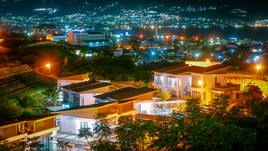
Back Palu ACE بالو Arabic پالو (اندونئزی) AZB Kota Palu BAN Палу (Сулавесі) Byelorussian Kota Palu BEW Kota Palu (kabupaten sa Indonesya) CEB Palu (Indonésie) Czech Palu German Paluo Esperanto
Palu | |
|---|---|
| City of Palu Kota Palu | |
Clockwise from the top: Palu seen at night, Palu Nusantara Gong of Peace, Nosarara Nosabatutu Peace Monument, Palontoan flyover, and Floating Mosque of Palu | |
| Motto(s): Maliu Ntuvu (Uniting all existing elements and potential) | |
 Interactive map of Palu | |
| Coordinates: 0°53′42″S 119°51′34″E / 0.89500°S 119.85944°E | |
| Country | |
| Region | Sulawesi |
| Province | |
| Incorporated | 1 July 1978 |
| City Status | 22 July 1994 |
| Government | |
| • Mayor | Hadianto Rasyid |
| • Vice Mayor | Reny A. Lamadjido |
| Area | |
• Total | 395.06 km2 (152.53 sq mi) |
| Elevation | 118 m (387 ft) |
| Population (mid 2023 estimate) | |
• Total | 387,493 |
| • Density | 980/km2 (2,500/sq mi) |
| [1] | |
| Time zone | UTC+8 (Indonesia Central Time) |
| Area code | (+62) 451 |
| HDI (2022) | |
| Website | www |
Palu, officially known as the City of Palu (Indonesian: Kota Palu), is the capital and largest city of Central Sulawesi Province in Indonesia. Palu is located on the northwestern coast of Sulawesi and borders Donggala Regency to the north and west, Parigi Moutong Regency to the east, and Sigi Regency to the south. The city boundaries encompass a land area of 395.06 km2 (152.53 sq mi). According to the 2020 Indonesian census, Palu had a population of 373,218, making it the third-most populous city on the island after Makassar and Manado; the official estimate as at mid 2023 was 387,493 - comprising 194,340 males and 193,150 females.[2] Palu is the center of finance, government, and education in Central Sulawesi, as well as one of several major cities on the island. The city hosts the province's main port, its biggest airport, and most of its public universities.
Palu is located in Palu Bay; it was initially a small agricultural town until it was selected to become the capital of the newly created province of Central Sulawesi in 1953. Palu is sited on the Palu-Koro Fault and is frequently struck by earthquakes, such as the 2018 Sulawesi earthquake. According to Indonesia's National Disaster Management Agency, the 2018 earthquake caused "the largest natural soil liquefaction phenomenon in the world".[3] Much of the city's infrastructure was destroyed and large swathes of land were rendered uninhabitable,[4] prompting the local government to plan to relocate the city to a safer location instead of rebuilding in the same place.[5]
- ^ Badan Pusat Statistik, Jakarta, 2024.
- ^ Badan Pusat Statistik, Jakarta, 2024.
- ^ Cite error: The named reference
BNPB-LargestSoilLiqwas invoked but never defined (see the help page). - ^ Cite error: The named reference
uninhabitablewas invoked but never defined (see the help page). - ^ Cite error: The named reference
KotaPaluBaruwas invoked but never defined (see the help page).








